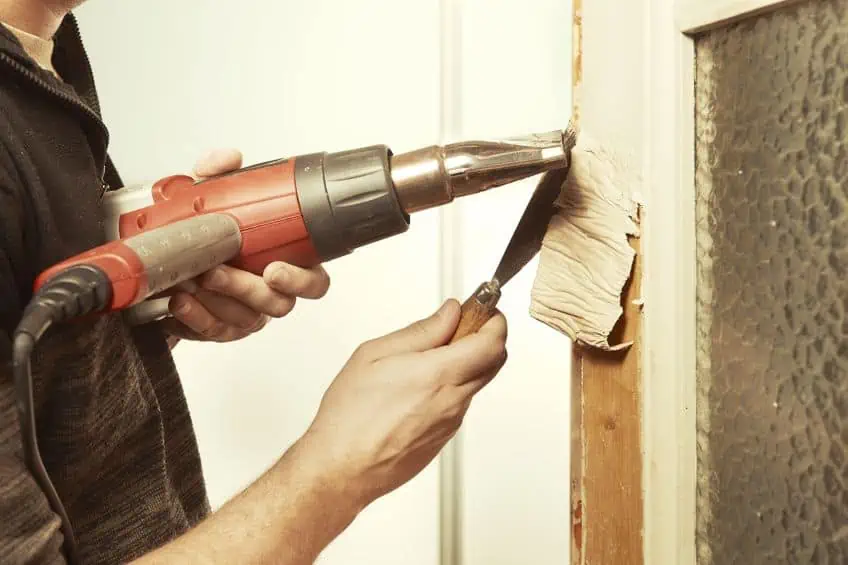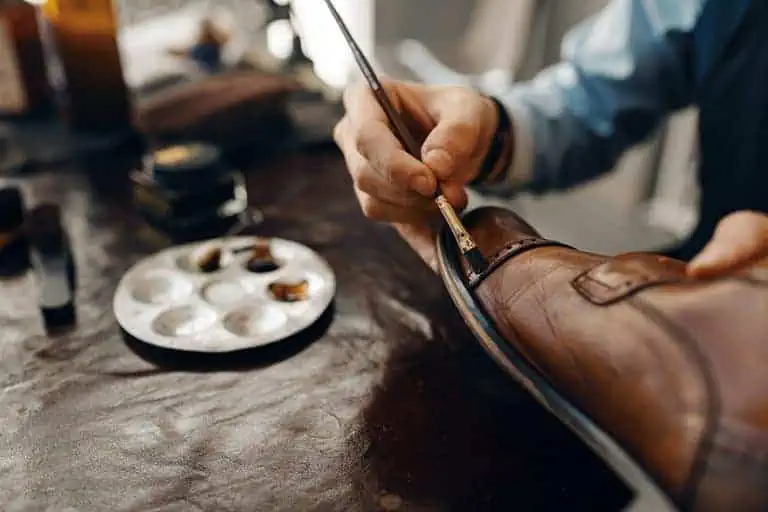How to Remove Acrylic Paint From Wood – What Removes Acrylic Paint
This post may contain affiliate links. We may earn a small commission from purchases made through them, at no additional cost to you.
It hasn’t always been easy to decorate your home. Before things like paint were readily available, the only way to make something unique was to smear it with berries or simply make it bigger and more intricate than your neighbors. Thankfully, these days we have so many types of paint and finishes available to us that the biggest obstacle we often face is choosing one we like! This does beg the question though, what happens when we want to remove paint from a surface? Acrylic paint is one of the most sold paints all around the world at the moment, and its typically used to paint wooden surfaces such as home exteriors, flooring, and even furnishings, so let’s have a look at what acrylic paint is and how to effectively remove it from surfaces.
Table of Contents
What Is Acrylic Paint?
Acrylic paint is somewhat of a new thing. Before acrylic was discovered, the only paint that we had available for both large- and small-scale painting applications was oil-based paints. Oil-based paints became something of a status quo for hundreds of years oil-based paint has been documented as being used as far back as the 7th century, being used to paint murals and detail important events on cave ceilings.
These paints were made using a combination of either berries and nuts, or when it came to fine art, a combination of nuts and linseed oils which produced vibrant colors that not only allowed artists to express themselves better but ensured that their work would last for many years to come. As the industrial revolution rolled around, oil-based paints and lead-based paints were now able to be mass-produced and therefore were more readily available. Unfortunately, as we know today, these paints contain harmful chemicals which affect one’s raspatory systems.
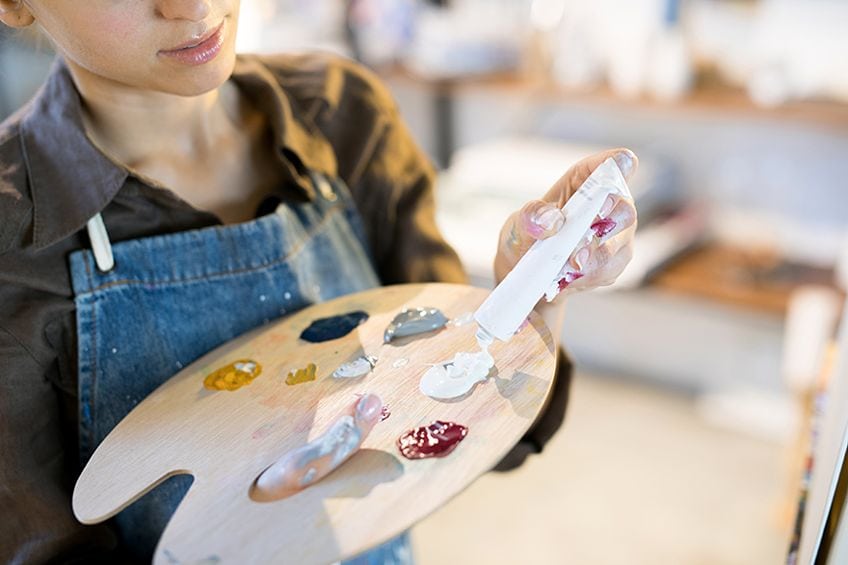
As time went on, we sought new ways to decorate our homes and furnishings, and toward the end of the second world war, acrylic paints became all the rage among not only those involved in the fine arts but in the construction and manufacturing industry too. The acrylic paint available at this point in time was crude and was a combination of oil and watercolor paints. Modern acrylic paint is far more sophisticated, being made from a range of pigments suspended in acrylic polymers. Acrylic paints are easier and often cheaper to manufacture as the ingredients needed to add color to the base material are easier to come by and more readily available, which explains why acrylic paints are typically cheaper than their oil-based counterparts.
Although they are cheaper and easier to make, this doesn’t mean that they are objectively superior to oil-based paints. Why? While oil-based paints and acrylic paints coat the surface they are applied to, oil-based paints penetrate beneath the surfaces of wooden workpieces and provide much-needed protection from things like heat, moisture, and insects.
Acrylic paints do not, and generally aren’t as robust and protection-focused as oil-based paints inherently are. However, acrylic paints contain far less volatile organic compounds (VOCs) than oil-based paints, and they’re typically cheaper which is why they are far more popular than oil-based paints are today.
Is It Difficult to Remove Acrylic Paint From Wood?
As we mentioned previously, acrylic paint isn’t as tough to remove from wooden surfaces as its oil-based counterpart, but it can still be challenging. Oil-based paints are actually largely water-based which means that if you catch a spill as soon as it lands on a wooden surface, you can easily remove it with some soap and water, however, if it’s allowed to dry it can be a bit more challenging to get rid of. Why? Well, while acrylic paint might not penetrate the surface of a wooden workpiece the way the oil-based paints do, it does have a pretty strong bond with the surface. This means that removing it can take some elbow grease, especially if you don’t have the right tools for the job. This is why it is really important to clean up acrylic paint as soon as you notice the spill. This is all well and good, but what happens if you want to remove acrylic paint from a surface that’s been there for a long time? This is pretty common when the paint on furniture gets a bit old and needs to be replaced.

In this case, there are a few methods you can use to ensure that your acrylic paint is removed from your wooden surface without damaging it. Unlike other paints on the market, acrylic paint is highly reactive to solvents, which means if you can get your hands on the right ones, you can remove old acrylic paint from a wooden workpiece with just a bit of elbow grease. Although if multiple coats of acrylic paints have been applied you might need to repeat the removal process and/or get a sander involved at some point. This being said, attempting to remove long-standing acrylic paint from a wooden surface by force could result in you completely ruining your workpiece. How? Well, using a power sander without removing the majority of the paint could cause the heat of the sander to smear the paint all over the workpiece, which means even more work for you. On the other hand, using a solvent that isn’t graded for use with acrylic paint could result in a nasty chemical reaction that could not only ruin your workpiece but produce harmful fumes in your workspace.
This is why it’s important to use the correct solvents when removing acrylic paint and ensure that you’re wearing the appropriate personal protective gear.
How to Remove Acrylic Paint From Wood
Generally, there are two instances in which you’d want to know how to remove acrylic paint from wood, either you’ve managed to spill some and need to know how to remove it quickly, or you’ve grown tired of an existing finish and want to remove it in an effort to replace it with a new one. Thankfully, we have you covered in both scenarios, so let’s have a look at how to get acrylic paint off wood whether it’s a recent spill or an old finish.
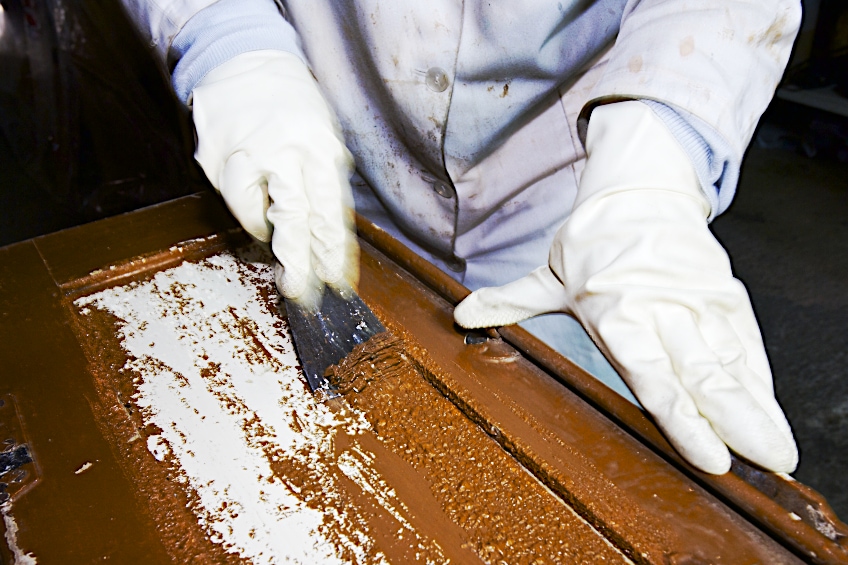
Using the Vegetable Oil Method
If you’re wondering how to remove dried acrylic paint from wood this is one of the best methods. Dried acrylic paint usually looks like a solid, but the way acrylic paints dry on the wooden surface is actually more of a caked coating than a replacement of the wood surface. This being said, here’s how to remove dried acrylic paint from wood using vegetable oil, as well as a few things you will need:
- A roll of paper towel
- Vegetable or olive oil
- A plastic scraper
- Some clean cloths
This method is generally used to remove acrylic paint from small furnishings and is a neat trick to keep in mind in case you ever find yourself in a pinch or crunched for time. First, get your olive oil/vegetable oil and roll of paper towels. Take a few sheets of paper towel and get a good amount of oil onto them, but do your best not to saturate the towels or you’ll have quite the mess on your hands.
Next, rub the now oil-filled paper towels on the are of your workpiece coated in the dried acrylic paint.
Once you’ve lathered the area up thoroughly, leave it to soak in for about 30 minutes, you should start to see the paint bubbling on the surface as the olive oil dissolves the bond it has with the wooden surface. Once the 30 minutes have passed, get your plastic scraper ready. It’s time to get your hands dirty. Use the scraper to gently lift the paint from the wooden surface without damaging the wood underneath. Get as close to the surface of the wood as possible and remove as much of the paint as you can. Repeat this process until all of the paint has been removed from your workpiece. Remember to wipe off any excess oil with a paper towel with each pass.
Using the Hot Water and Soap Method
Here’s how to get acrylic paint off wood using some hot water and ordinary household soap, but keep in mind that this method will only work if the paint is still wet and is most effective when you find yourself needing to remove acrylic paint from varnished wood surfaces. All that you’ll need for this method is the following:
- Hot or warm water
- An ordinary cloth
- Some dishwashing liquid
This method is pretty self-explanatory, but before you go ahead and smother the paint in hot water you should probably remove the excess. You could use a spare piece of cardboard or a plastic knife to scrape up the excess and remove it from the floor. Once you’ve got most of it cleaned up, you’ll notice a stain left by the acrylic polymer, and this is where the hot water and soap come in.
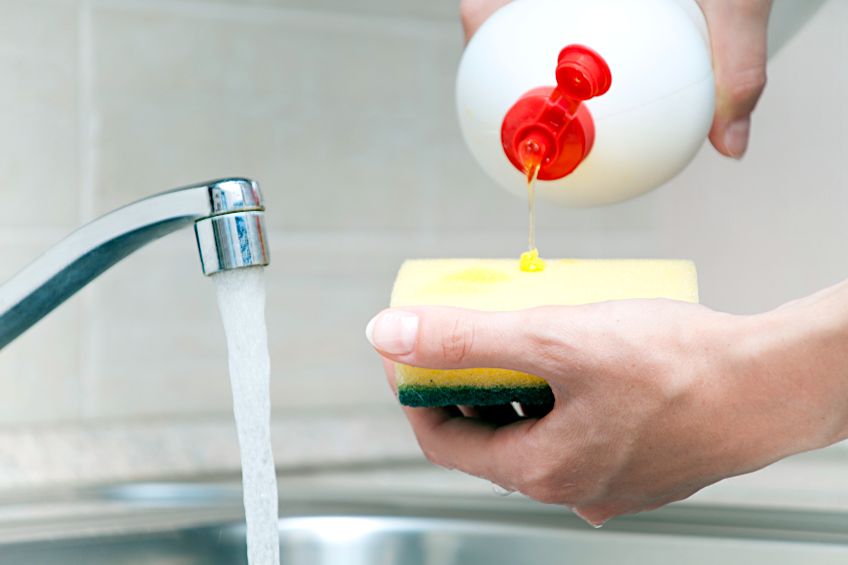
Soak your cloth in the water and train out the excess, then use your cloth to scrub the surface in a circular motion to remove the majority of the stain. Ensure to rinse your cloth regularly to avoid spreading the stain further. Once the stain has been removed, allow the surface to dry completely (use a dry cloth if it’s really wet), and if there is still a stain present repeat the process as many times as needed.
Using the Rubbing Alcohol Method
If you’re looking for a great way to get acrylic paint off hardwood floors, we recommend getting your hands on some rubbing alcohol. This method not only works on wet and dry paint off wooden surfaces but is one of the tried-and-true ways to get acrylic paint off hardwood floors, which is notoriously difficult thanks to the wood these floors tend to be made of. Here are a few of the things you’ll need:
- Some rubbing alcohol
- Some ordinary cloths
- A plastic scraper
- A scrubbing sponge or steel wool
This might go against every instinct you have when it comes to dealing with hardwood floors, but you’re going to need to use your plastic scraper to remove some of the dried paint from the wooden surface beforehand. Use your scraper and remove the paint layer by layer, try not to do too much at once or you could end up ruining the surface. Now get your hands on that rubbing alcohol. We don’t recommend over-saturating the cloth in running alcohol but get as much on there as you can. Next, quickly apply the cloth to the affected area of the wood and allow the alcohol to soak in before it evaporates. The goal here is to get as much rubbing alcohol onto the affected area without damaging the wood or over-saturating the cloth.
Now it’s time to get out your steel wool. Use it to focus on the affected area and remove the majority of the paint from the surface. Be careful not to go too hard or you might end up scratching your hardwood floor, which will only lead to more work later on.
You can go ahead and soak your steel wool in some rubbing alcohol too to save yourself some elbow grease. At this point, you should have most of the acrylic paint removed from the surface. What’s left should be a shallow stain with some harder bits scattered about. Set aside your steel wood and get your hands on a cloth and some hot/warm water. Soak the cloth in the water and ring out the excess, then using some considerable elbow grease scrub away the remaining paint. The water not only neutralizes the alcohol but ensures that the remaining paint is slowly broken down in conjunction with the friction of you scrubbing back and forth. This method ensures that your hardwood floors are preserved and that you aren’t left with any residual stains once you’re done scrubbing the surface.
Using the Heat Gun Method
Using a heat gun is one of the best methods of getting rid of acrylic paint on a larger surface, particularly ones that are vertical. If you’re working with smaller surfaces like a small cupboard or a nightstand you’’ have a better time using one of the methods we’ve covered previously. Heat guns are great for all manner of crafts, and they’ve become relatively inexpensive in recent years, so you won’t have much trouble getting your hands on one. Here are a few things you’ll need to get started:
- A heat gun
- Gloves
- A plastic scraper
- A clean cloth
- A face mask
- Eye goggles
Before you get started it’s important to gear up. Why? Acrylic paint contains some chemicals that become volatile when exposed to direct heat, this can cause the release of harmful chemicals that can cause serious discomfort if inhaled or if they come into contact with your skin or eyes. This being said, pop on your gloves, face mask, and goggles to ensure that you are properly protected. Now that you have on all of your personal protective gear it’s time to plug in your heat gun. Once it’s powered up, set it to the highest heat setting (if you have variable temperature control). Once you have it all heated up, get yourself within a medium distance (roughly four feet) from the surface in question and begin applying heat. The trick here is to apply heat consistently in a circular motion to ensure that the paint is raised equally.
At this point, you should notice that the paint has either begun to bubble up or crack on the surface. This is how you know that your heat treatment is working, and you can move on to the next step in the process. Get your plastic scraper ready and begin to carefully lift the paint from the surface of the wooden workpiece.
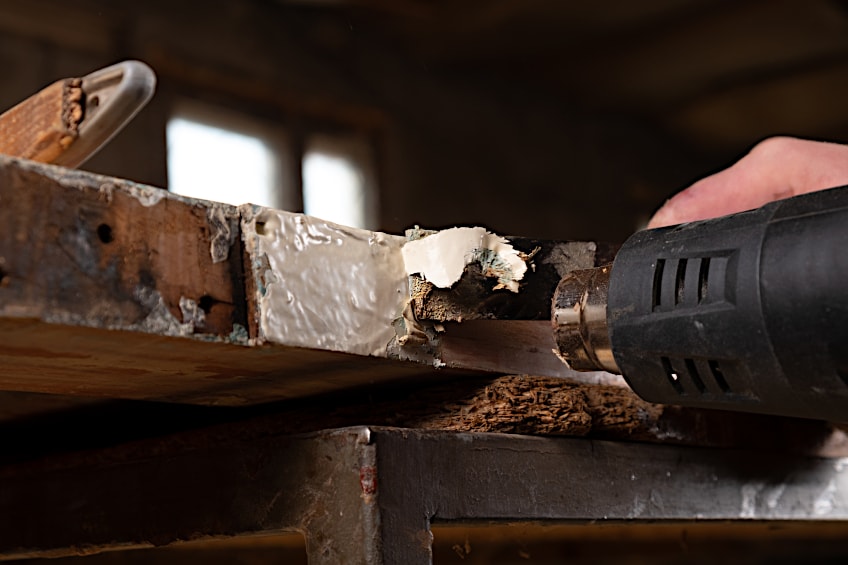
The trick here is to apply heat to the paint and remove it at the same time to ensure that the paint is as soft as possible as you progress. This might be a bit challenging at first, but with some practice, you should get the hang of things pretty easily, plus once you see how effective this method is on large surfaces, you’ll likely be motivated to keep at it until you find your own rhythm.
Once most of the paint has been removed from the surface of the workpiece get your cloth and some warm soapy water. Soak the cloth in the water and ring out the excess. Use the cloth to scrub away any residual paint, and if you encounter any stubborn pieces use your plastic scraper to get rid of them. Once all of the paint has been removed from the surface of the workpiece, use some clean water to neutralize the effect of the soap and dry the surface with a clean cloth once done. Allow the surface to air dry completely before preparing to resurface the workpiece.
Using the Solvent Method
Using a solvent to remove acrylic paint is what most professional crafters and contractors do when there’s a nasty paint spill or when they’re refurbishing older furniture. Why do they use this method you ask? Well, it’s one of the easiest, most effective, and least time-consuming means of removing acrylic paint from a wood surface. Before you get started, you should know that it’s really important to ensure that your workspace is well-ventilated and that you’re wearing the appropriate personal protective gear as solvent fumes can be harmful. Here are a few of the things you’ll need:
- Lacquer/thinner/methylene chloride/ ammonia
- A pair of gloves
- A face mask
- Some clean cloths
- A plastic scraper
- A brush or fine nap roller
- Some eye goggles
- Mineral spirits
- Some water
As we mentioned previously, this is one of the most effective methods of removing acrylic paint from wood, but it is also one of the riskiest due to the chemicals involved in the softening process. That’s why you should probably gear up before you get started, put on your face mask, your gloves, and your goggles to ensure that your face and hands are adequately protected. Once you have all of your gear on get your solvent of choice ready. If you have a painter’s tray, pour some solvent into it and allow your roller or brush to soak in it for a few minutes. Five minutes should be enough, but this does depend on the concentration of the chemicals in question, so always read the manufacturer’s instructions beforehand. Once your brush/roller has been soaked, remove it and move on to the next step.
The next step also involves some soaking. Use your brush or roller to apply your solvent to the affected area of the workpiece. The goal here is to saturate the area with solvent to soften the paint as much as possible.
Allow the solvent to soak into the paint for around half an hour, but again, this depends on the strength of the chemical so consult the manufacturer’s guidelines to be sure. After the solvent has had some time to soak in you should see the paint start to bubble on the surface (not to mention quite a strong smell). This means that the solvent is doing its thing and that you should get your plastic scraper ready. Use the scraper to remove the bulk of the paint from the surface of your workpiece, just be sure to scrape in the direction of the wood grain to avoid damaging the surface of your workpiece.

Next, it’s time to get your clean clothes and mineral spirits. Add some mineral spirits to your cloth without saturating it, then rub the cloth on the surface you just scraped the paint off. The goal here is to neutralize the solvent before it starts eating away at your wood, but it also helps remove any residual paint from the surface of the workpiece. Now that you have most (if not all) of the paint removed from the surface of your workpiece, use a damp cloth (no soap) to wipe off any paint that might have been smeared across the surface of the workpiece. Once done, allow the surface to dry completely before attempting to resurface or add a new coat of paint.
That’s it! Now that you know what acrylic paint is, why it can be challenging to remove, as well as some of the best methods to removing both wet and dry acrylic paint from a range of wooden surfaces, it’s time for you to get out there and put your new-found knowledge to the test. Remember to always wear the appropriate personal protective gear and to work in a well-ventilated area when working with solvents.
Frequently Asked Questions
What Removes Acrylic Paint?
Wondering what removes acrylic paint? Although it does depend on the material of your workpiece, there are loads of things you can use to remove acrylic paint from a surface. Some of the most effective means of doing so are directed heat, solvents, rubbing alcohol, or simply some soap and water that will get the job done.
Is It a Good Idea to Use Acrylic Paint for Woodwork?
Is it a good idea to use acrylic paint for woodwork? When painting wood there are many paints to choose from, but some of the most effective and long-lasting finishes are found when using oil-based and acrylic paints. These paints provide protection for external forces and have some beautiful textures to choose from.
What Are Acrylic Paints Used For?
Acrylic paints are one of the most versatile paint types on the market today. They can be used on many surfaces, including card, metal, plastic, wood, glass, fabrics, leathers, and even resin surfaces. These paints are easy to use, relatively inexpensive, and will protect your workpiece well.
In 2005, Charlene completed her wellness degrees in therapeutic aromatherapy and reflexology at the International School of Reflexology and Meridian Therapy. She worked for a company offering corporate wellness programs for several years before opening her own therapy practice. In 2015, she was asked by a digital marketer friend to join her company as a content creator, and it was here that she discovered her enthusiasm for writing. Since entering the world of content creation, she has gained a lot of experience over the years writing about various topics such as beauty, health, wellness, travel, crafting, and much more. Due to various circumstances, she had to give up her therapy practice and now works as a freelance writer. Since she is a very creative person and as a balance to writing likes to be active in various areas of art and crafts, the activity at acrylgiessen.com is perfect for her to contribute their knowledge and experience in various creative topics.
Learn more about Charlene Lewis and about us.
